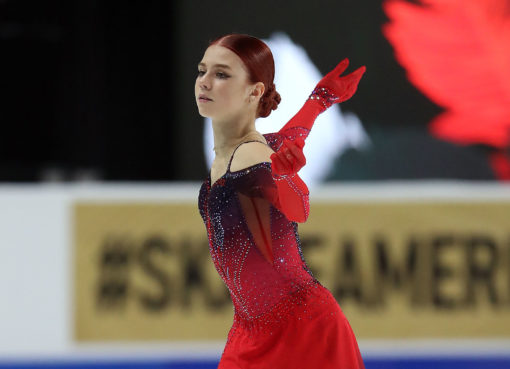 If Marissa Castelli and Simon Shnapir took one thing from the Trophee Eric Bompard in Paris, France, it is inspiration for future events. “In our rink we’re the top pair skaters, so being around these teams gives us something to strive for and pushes us to skate better,” Castelli said.
If Marissa Castelli and Simon Shnapir took one thing from the Trophee Eric Bompard in Paris, France, it is inspiration for future events. “In our rink we’re the top pair skaters, so being around these teams gives us something to strive for and pushes us to skate better,” Castelli said.
The young Americans, who were third at the World Junior Championships earlier this year, finished seventh in their senior debut. They were seventh in the short program and the free skate for 133.01 points overall.
Russians Maria Mukhortova and Maxim Trankov (192.93) won the gold medal following a solid performance that was helped by the complete melt down of World Champions Aliona Savchenko and Robin Szolkowy (174.42) of Germany, who won bronze. Canadians Jessica Dube and Bryce Davison were third with 180.97.
The Russians far surpassed their personal best in the free skate, traditionally the weaker program for the two, by scoring a 126.05. All of their elements received the highest level except the opening triple twist. Their performance included side-by-side double axels, side-by-side triple toe-double toe combinations, a throw triple loop and a throw triple Salchow.
Savchenko and Szolkowy’s problems started from the beginning of the fourth place free that earned them a score of only 101.44, more than 20 points off their personal best. The second jump in the triple toe-triple toe sequences was downgraded to a double and received a negative grade of execution. In the spiral sequence, the two lost grip in their first position, causing her to fall. The pair fell on the side-by-side triple Salchows and fell out of the death spiral before singling the final throw of the program.
Two-time U.S. Champions Rena Inoue and John Baldwin were third in the free skate but finished fourth overall with 158.36 points. Among the highlights of their program, which was skated on Inoue’s 33rd birthday, were a throw triple loop and a throw triple axel that received 9.65 points alone.
Castelli and Shnapir landed side-by-side triple Salchows and single axel-double toes in sequence. Although their throw triple Salchow and throw double axel both received a negative grade of execution, they did receive positive marks for several other elements including the double twist.
“It went pretty well,” Castelli said. “We didn’t really expect too much, competing with these top pairs. We just wanted to go out and skate the best we could and learn from the experience.
The competition continues with the ladies free skate, which includes 2008 U.S. Junior Ladies Champion Alexe Gilles, the free dance later Saturday. Yu-Na Kim of Korea leads ladies while Canadians Tessa Virtue and Scott Moir lead ice dance.
Trophee Eric Bompard is the first event of the 2009 International Skating Union (ISU) Grand Prix of Figure Skating circuit. The series, now in its 15th season, consists of six international events in a cumulative, point-scoring format. The top six scoring athletes in each discipline move onto the Grand Prix Final, Dec. 3-6, in Tokyo, Japan, which will be combined with the ISU Junior Grand Prix of Figure Skating Final for the second consecutive season.
The six Grand Prix events are Trophee Eric Bompard, Oct. 15-18, in Paris, France; Rostelecom Cup, Oct. 22-25, in Moscow Russia; Cup of China, Oct. 29-Nov. 1, in Beijing, China; NHK Trophy, Nov. 5-8, in Nagano, Japan; Skate America, Nov. 12-15, in Lake Placid, N.Y.; and Skate Canada, Nov. 19-22, in Kitchener, Canada.
The points toward the Grand Prix Final that are awarded for each place are 15 points for first; 13 points for second; 11 points for third; nine points for fourth; seven points for fifth; five points for sixth place; four points for seventh place; and three points for eighth. In pair skating, only the top six receive points.
__________
Figure Skaters Online strives to be an accurate source of information related to the sport of figure skating. To report an error, please e-mail the news editor. Include the article date and title in your e-mail.



